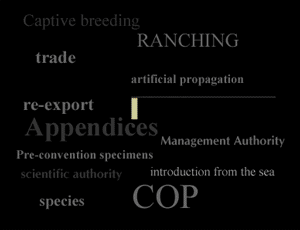|
The CITES glossary
 CITES is a convention at the crossroads of natural sciences and international law. The terminology it uses reflects those highly specialized domains and can seem bewildering to non specialists. Furthermore some terms may have a definition in CITES that differs from the generally accepted one, as is for instance the case of ‘species’ defined in Article I, paragraph (a), of the Convention as “any species, subspecies, or geographically separate population thereof”. In order to help users of its website, the Secretariat has created a glossary of CITES terms under the section ‘Resources / Terminology’ as a practical way of accessing numerous definitions of CITES terms from a single source. CITES is a convention at the crossroads of natural sciences and international law. The terminology it uses reflects those highly specialized domains and can seem bewildering to non specialists. Furthermore some terms may have a definition in CITES that differs from the generally accepted one, as is for instance the case of ‘species’ defined in Article I, paragraph (a), of the Convention as “any species, subspecies, or geographically separate population thereof”. In order to help users of its website, the Secretariat has created a glossary of CITES terms under the section ‘Resources / Terminology’ as a practical way of accessing numerous definitions of CITES terms from a single source.
This glossary adds to the already existing English-French and English-Spanish lexicons. The latter functions like a bilingual dictionary, providing the translations of a larger number of terms, expressions and acronyms. The glossary, on the other hand, provides a shorter list of terms but with definitions.
The basis for this glossary has been the compilation of the terms that are defined in the text of the Convention or in Resolutions. To this first set have then been added terms that complete it logically. For instance the Conference of the Parties has agreed on a definition for ‘breeding stock’ (animals) in Resolution Conf. 10.16 (Rev.), but not for ‘parental stock’ (plants). The Secretariat has therefore created a definition for ‘parental stock’ based on the one for ‘breeding stock’.
Each entry gives the following information:
| 1) |
A definition. Cross-reference hyperlinks are shown in blue and allow for navigation within the glossary. Some entries simply indicate a hyperlink to a document or another section of the website. |
| 2) |
A 'See also' section that gives hyperlinks to related terms, or to relevant Web pages or documents outside the glossary. |
| 3) |
The source of the definition, indicating whether it has been: |
| |
a) |
lifted word for word from existing text (indicated as “Definition from …”); |
| |
b) |
adapted from existing text (indicated as “Definition adapted from …”), when some editorial changes have been made (in particular to standardize the presentation of definitions); or |
| |
c) |
formulated by the Secretariat, as in the example given above. In this case no source is indicated. |
| 4) |
The French and Spanish equivalents. |
|
|
The glossary is currently available in English only, but French and Spanish versions are being produced and will be made available at a later stage. It will also be expanded regularly as the Conference of the Parties adopts or revises new definitions, or as new terms make their way into the CITES jargon. Comments on the glossary are welcome and should be sent to laurent.gauthier@unep.ch.
|